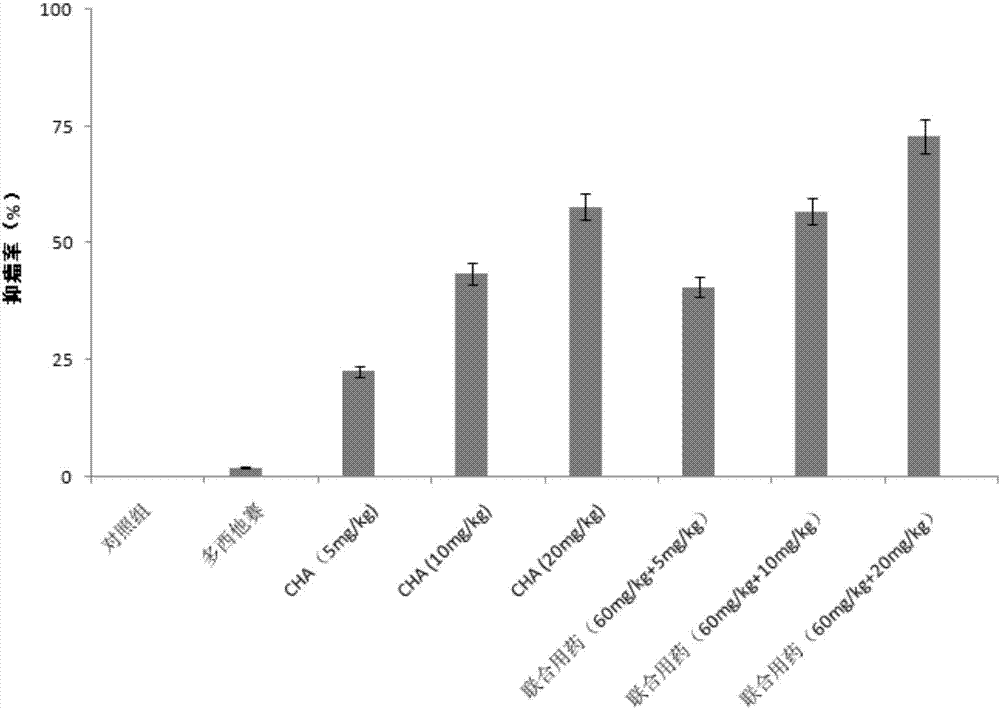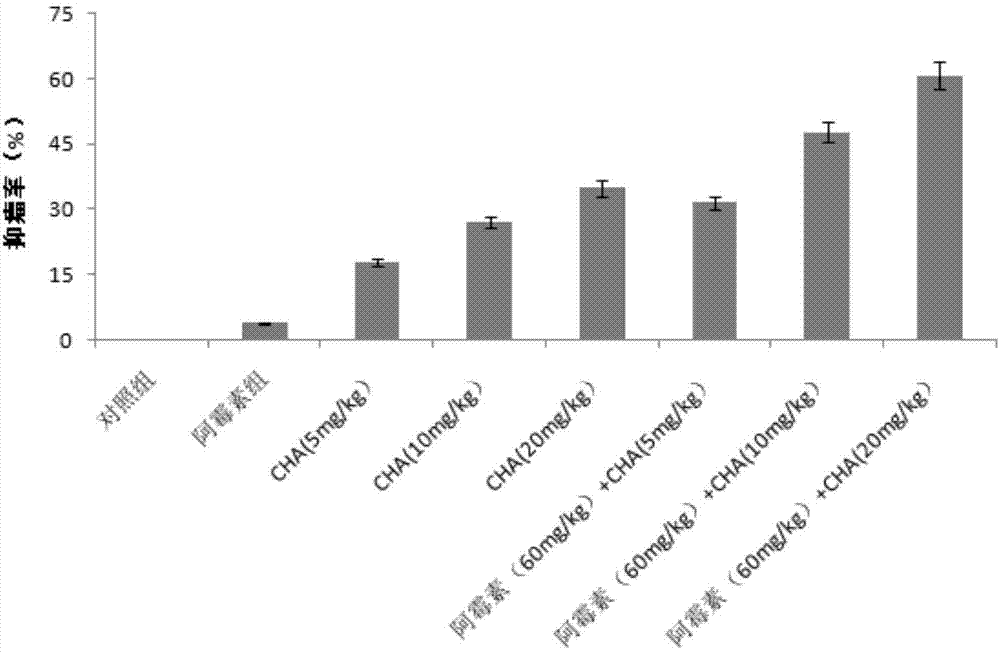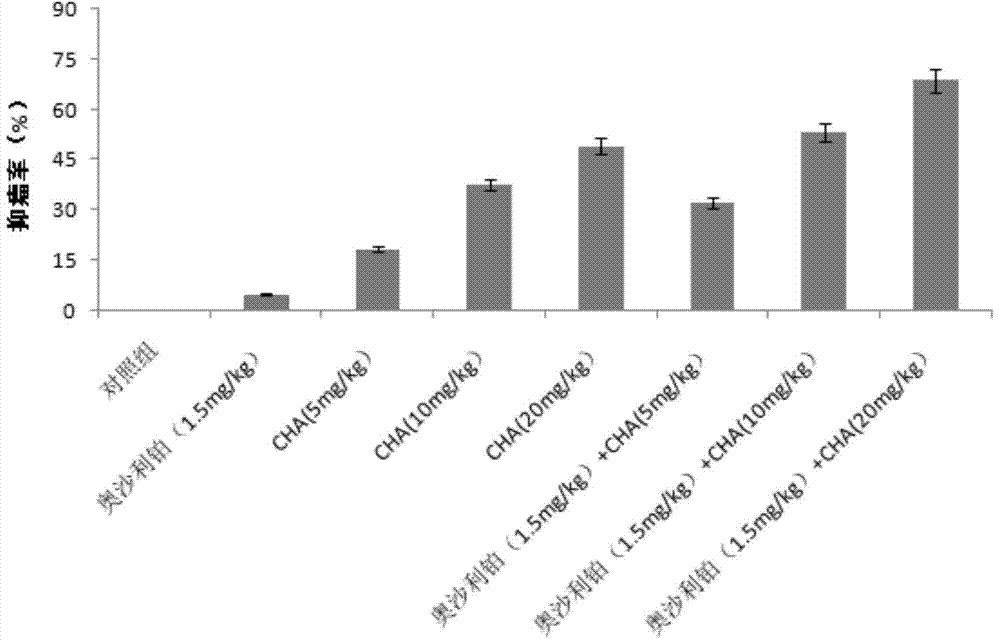Uses of chlorogenic acid in preparation of drugs treating multidrug resistance of cancer
A multi-drug resistance and chlorogenic acid technology, which is applied in drug combinations, antineoplastic drugs, pharmaceutical formulations, etc., can solve the problems of drug resistance affecting the application effect of drugs, so as to eliminate drug resistance and solve limit problems Effect
- Summary
- Abstract
- Description
- Claims
- Application Information
AI Technical Summary
Problems solved by technology
Method used
Image
Examples
Embodiment 1
[0045] Example 1 Establishment of drug-resistant tumor cell model
[0046] Take the human breast cancer cell line BCap37 in the logarithmic growth phase and digest it with 0.25% trypsin; resuspend the cells in the complete culture medium and pipette evenly to make a single cell suspension; count the cells and adjust the cell concentration to 2x10 4 cells / ml; 200 μL cell suspension per well was inoculated into a 96-well plate (each well contains about 4000 cells); 2 , saturated humidity, cultivated in a constant temperature incubator at 37°C for 12 hours; added paclitaxel at a concentration of 300nM, and set up 6 replicate wells; 2 , saturated humidity, and cultivated in a constant temperature incubator at 37°C for 72 hours. Using breast cancer cell BCap37 as the parental cell and paclitaxel as the screening drug, the multidrug-resistant cell Bats-72 was successfully established. Bats-72 has broad-spectrum drug resistance, and has strong resistance to chemotherapy drugs such ...
Embodiment 2
[0047] Example 2 Experiment of Inhibitory Rate of Mouse Multidrug-resistant Breast Cancer Model
[0048] (1) Experimental method
[0049] The multidrug-resistant breast cancer model in mice uses C57BL / 6 mice, male, 18-22g. During the experiment, Bats-72 cells in the logarithmic growth phase were taken to make a concentration of 2.5x10 4 / ml of tumor cell suspension, each mouse was inoculated with 0.2ml of tumor fluid in the back of the armpit. Animals were randomly grouped, weighed, and dosed started the day after inoculation. Experimental animals were divided into 9 groups, including negative control group, control group, docetaxel group, chlorogenic acid 5mg / kg, 10mg / kg, 20mg / kg group, docetaxel and chlorogenic acid 5mg / kg, 10mg / kg, 20mg / kg in three dose groups, 20 animals in each group. The administration volume of chlorogenic acid injection was intraperitoneally injected 0.2ml per 10g of mice, once a day, and administered continuously for 24 days. The dose of docetax...
Embodiment 3
[0055] Example 3 Experiment of Inhibitory Rate of Mouse Multidrug-resistant Small Cell Lung Cancer Model
[0056] (1) Experimental method
[0057] Mouse multidrug-resistant small cell lung cancer model, BALB / c mice, male, 18-22g. The model cell used in the experiment is the human small cell lung cancer multidrug-resistant cell line GLC4 induced by mitoxantrone (Mx). During the experiment, GLC4 cells in the logarithmic growth phase were taken to make a concentration of 2.5x10 4 / ml of tumor cell suspension, each mouse was inoculated with 0.2ml of tumor fluid in the back of the armpit. Animals were randomly grouped, weighed, and dosed started the day after inoculation. Experimental animals were divided into 9 groups, including negative control group, control group, doxorubicin group, chlorogenic acid 5mg / kg, 10mg / kg, 20mg / kg group, doxorubicin 60mg / kg and chlorogenic acid 5mg / kg, 10mg / kg, 20mg / kg combined drug in three dose groups, 20 animals in each group. The administrati...
PUM
 Login to View More
Login to View More Abstract
Description
Claims
Application Information
 Login to View More
Login to View More - Generate Ideas
- Intellectual Property
- Life Sciences
- Materials
- Tech Scout
- Unparalleled Data Quality
- Higher Quality Content
- 60% Fewer Hallucinations
Browse by: Latest US Patents, China's latest patents, Technical Efficacy Thesaurus, Application Domain, Technology Topic, Popular Technical Reports.
© 2025 PatSnap. All rights reserved.Legal|Privacy policy|Modern Slavery Act Transparency Statement|Sitemap|About US| Contact US: help@patsnap.com



